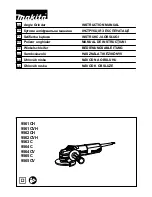
REVOLUTION MIXING
It will be necessary to adjust the revolution mixing to properly com-
pensate for the torque of the engine during all flight conditions (except
autorotation). Since there are many variables that can alter the value of the
revolution mixing, it will be necessary to fine tune this function during test
flights. The following values are shown only as a starting point toward
achieving proper compensation:
GYRO GAIN ADJUSTMENT FOR JR G400 GYRO
It will be necessary to adjust the “gain” or compensation of the gyro
to create the correct amount of “holding power” necessary for a solid neu-
tral tail rotor. The intent of the gyro is to compensate for abrupt movements
or wind direction changes, working in conjunction with the revolution mix-
ing function.
For hovering, it is recommended that you start with the gyro gain at
approximately 80°, and continue to increase slightly until the tail of the
helicopter “hunts,” then reduce the value slightly.
This function is used to compensate for the reaction torque which can
not be controlled by Revolution Mixing. In case of G400 gyro, adjustment
can be achieved with the volume knob located on the gyro. Turn the knob
fully counter clockwise, then clockwise so that the knob will be at 40% to
50% of the full stroke. It will be necessary to fine tune during test flights
and it is recommended the gyro gain be set higher for more stable rudder.
Increase the value until the tail of the helicopter “hunts,” then reduce the
vales slightly.
GYRO GAIN VALVES FOR REMOTE GAIN GYROS
This same adjustment will also be necessary to achieve proper for-
ward flight. Generally, the gyro gain for forward flight will be approximately
10–20% less than that of the established hover gain due to aerodynamic
forces present in forward flight.
If you’re using a dual rate gyro, adjust the gain so that you’re using “higher”
gain setting for hover and the “lower” gain setting for forward flight. It will
also be necessary to confirm the direction the gyro compensates when the
body of the helicopter is rotated.
To do this, turn the radio system on and suspend the helicopter by
the main rotor head. Next, move the rudder stick to the right and watch the
direction that the tail rotor servo arm travels. Now while watching the tail
rotor servo arm, rotate the body of the helicopter counterclockwise. The
servo arm should move in the same direction as when the rudder stick was
moved to the left. If the arm moves in the opposite direction, reverse the
gyro and re-test.
48
[ATS REVO-MIX]
DIR-RIGHT
-POS-
UP
DN
P
HOV
ZERO
5%
5%
0%
50
0
ENTER
PAGE
STORE
STORE
SEL
NORM
+
–
CL
+
–
CL
+
–
CL
Make certain that the compensation
direction is set to “Right.”
PCM 10 Series radio with NEJ400 and NEJ450 Gyros
[GYROS SENS ADJ]
AUX3
0:
1:
2:
∞ 80%
60%
50%
ENTER
SEL
+
–
CL
+
–
CL
+
–
CL
Press SEL to select AUX3 or AUTO GAIN Function
Please refer to your radio’s instructions for more information.
PCM 10 Series radio with NEJ450 and other remote gain gyros
[ATS. MIX]
REVO.Mix
NORM
∞Up R5%
DN R5%
STNT
ACC.Mix
Up R3%
Dn R3%
0%
XP8103 with NEJ400 and NEJ450 Gyros
mix
rvu
+
+5
5
mix
rv
D
+
+5
5
XP652 with NEJ400, NEJ450 Gyros
XP652 with NEJ450 and other remote gain gyros
ger
trv. adj.
-60
%
Channel
Make sure that the direction is set to R (right)
[GYRO SENS]
RUDD D/R
£Rate:
∞0:
80%
1:
60%
XP8103 with NEJ450 and other remote gain gyros
Change
switch
position
Set to Rudd
D/R Switch
FINAL SERVO ADJUSTMENT AND RADIO SET UP (CONTINUED)
ger
trv. adj.
+80
%
Содержание Voyager E
Страница 43: ...43 DECAL PLACEMENT...
Страница 71: ...71 NOTES...
Страница 72: ...2000 Horizon Hobby Inc Distributed Exclusively by Horizon Hobby Inc www horizonhobby com...
















































